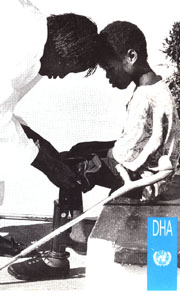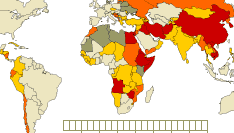Dozens of Nations, But Not U.S., Sign Land-Mine Treaty
By Howard Schneider
Washington Post Foreign Service
Thursday, December 4, 1997; Page A33
The Washington Post
OTTAWA, Dec. Foreign ministers from dozens of
nations signed a treaty today banning the
production and use of anti-personnel land
mines, the cornerstone of efforts to eliminate
a device that has served as a military staple
but is now viewed as a scourge for civilians
who live near abandoned minefields.
 Used extensively in civil, regional and world
conflicts during this century, tens of millions
of the weapons remain buried in former war
zones, killing and injuring thousands of
civilians annually and turning a walk to school
or to the well into a daily hazard.
Used extensively in civil, regional and world
conflicts during this century, tens of millions
of the weapons remain buried in former war
zones, killing and injuring thousands of
civilians annually and turning a walk to school
or to the well into a daily hazard.
After a five-year campaign that was initiated
by private advocacy groups, given a high
profile by Princess Diana and provided
diplomatic impetus by Canada, the global ban
became a reality this morning.
Foreign ministers from Canada, Norway and South
Africa were the first to sign, with diplomats
from approximately 125 countries expected to
add their signatures by Thursday. Ratification
by those nations is expected to follow quickly.
The outpouring of support, led by middle-size
powers such as Canada and representatives from
all continents, showed that disarmament goals
can be reached even without the signatures of
the world's three principal military powers,
said Jody Williams, coordinator of the
International Campaign to Ban Landmines and
recipient of this year's Nobel Peace Prize.
"In the next century, we can live in a
mine-free world where we are the superpower,"
Williams said, referring to the coalition of
government and nongovernmental groups that
produced the treaty. "The post-Cold War world
is different."
 Neither the United States, Russia nor China is
signing the treaty, although the Clinton
administration is committing $80 million
annually to mine-clearance programs and has set
deadlines for the Pentagon to find alternatives
to cope with situations in which its
strategists still find the mines useful. The
chief concern is for U.S. troops stationed in
South Korea, where land mines are used to
defend against a possible attack by Communist
North Korea.
Neither the United States, Russia nor China is
signing the treaty, although the Clinton
administration is committing $80 million
annually to mine-clearance programs and has set
deadlines for the Pentagon to find alternatives
to cope with situations in which its
strategists still find the mines useful. The
chief concern is for U.S. troops stationed in
South Korea, where land mines are used to
defend against a possible attack by Communist
North Korea.
Karl F. Inderfurth, the newly appointed U.S.
special representative for global humanitarian
demining, attended the treaty signing
conference as an observer. He said that even
though the United States is not signing, it
supports the treaty's goals.
"This is something our government is committed
to," he said, explaining that Washington will
back the demining effort that treaty supporters
now hope to undertake. "Our hearts are in the
right place. There is absolute commitment to
the humanitarian cause. . . . We do have
military, national security requirements."
That was not good enough for the other
Americans here, including members of
nongovernmental groups that helped initiate the
land mine ban and politicians, such as Sen.
Patrick J. Leahy (D-Vt.), who have introduced
legislation they hope will force President
Clinton to sign the treaty.
 "Our country is sitting on the sidelines," said
Susannah Sirkin, deputy director of Physicians
for Human Rights. "It is time for President
Clinton to take the most minimal of risks."
"Our country is sitting on the sidelines," said
Susannah Sirkin, deputy director of Physicians
for Human Rights. "It is time for President
Clinton to take the most minimal of risks."
Other countries that are not signing include
Israel and its Arab neighbors, as well as
Pakistan, India, Turkey and Afghanistan.
Still, the treaty was heralded here today as a
victory of humanitarianism over perceived
military necessity. When the idea of a ban was
first broached five years ago, then set as a
diplomatic goal by Canada at a conference in
1996, supporters said there was suspicion among
strategists and doubt among diplomats.
The treaty is "a landmark step in the history
of disarmament . . . a victory for the weak and
vulnerable of the world," said U.N. Secretary
General Kofi Annan. "One does not have to be a
global superpower to affect the future of peace
and security."
 Canadian Prime Minister Jean Chretien, whose
government became the first both to sign and
ratify the treaty, said its impact would be
felt "from the rice fields of Cambodia to the
suburbs of Kabul, from the mountainsides of
Sarajevo to the plains of Mozambique."
Canadian Prime Minister Jean Chretien, whose
government became the first both to sign and
ratify the treaty, said its impact would be
felt "from the rice fields of Cambodia to the
suburbs of Kabul, from the mountainsides of
Sarajevo to the plains of Mozambique."
"Let us say to all the children of the world
that you will walk again through the fields and
climb the trees in the forests, in a world free
from mines."
As representatives from various countries
continued signing the treaty today, attention
turned to what conference organizers say may be
the more difficult and important task --
mobilizing governments, private groups and
businesses to remove the large concentrations
of mines remaining in such countries as Angola
and Bosnia.
Chretien announced that Canada will contribute
about $15 million annually to the effort, and
Inderfurth said he thinks the U.S. contribution
will climb to $100 million next year. Other
countries also are planning to contribute, as
are private groups.
At news conferences here today, initiatives
were announced for an "Adopt-A-Minefield"
campaign in the United States to raise money in
communities for mine clearance. There is also a
group called Students Against Landmines that is
to carry the effort into schools.
And, recognizing that minefields often occupy
otherwise arable land, three California
vintners -- Robert Mondavi Winery, Wente
Vineyards and Beringer Vineyards -- announced a
"Mines-to-Vines" program that would try to
recover potential grape-growing regions in
Bosnia and elsewhere.
THE VICTIMS
 is killed or injured by a mine every
22 minutes.
is killed or injured by a mine every
22 minutes.
A person by a mine every
22 minutes.
A person is killed or injured every
22 minutes.
A person is killed or injured by a mine
WHO THE VICTIMS ARE
Males over age 15: 68.7%
Females over age 15: 7.3%
Children under age 15: 19.8%
Unspecified: 4.2%
| This is what a landmine does to you: 
|
HOW THEY WERE HURT
Fighting: 13%
Civilian activity 83%
Demining 4%
|
Includes playing with mines, tending fields
and fetching water
Leading exporters/producers of anti-personnel
land mines
(in alphabethic order)
Copyright 1997 The Washington Post Company
I see many former countries on this exporters list. I hope this come as a hint to the rest.

 Used extensively in civil, regional and world
conflicts during this century, tens of millions
of the weapons remain buried in former war
zones, killing and injuring thousands of
civilians annually and turning a walk to school
or to the well into a daily hazard.
Used extensively in civil, regional and world
conflicts during this century, tens of millions
of the weapons remain buried in former war
zones, killing and injuring thousands of
civilians annually and turning a walk to school
or to the well into a daily hazard.
 Neither the United States, Russia nor China is
signing the treaty, although the Clinton
administration is committing $80 million
annually to mine-clearance programs and has set
deadlines for the Pentagon to find alternatives
to cope with situations in which its
strategists still find the mines useful. The
chief concern is for U.S. troops stationed in
South Korea, where land mines are used to
defend against a possible attack by Communist
North Korea.
Neither the United States, Russia nor China is
signing the treaty, although the Clinton
administration is committing $80 million
annually to mine-clearance programs and has set
deadlines for the Pentagon to find alternatives
to cope with situations in which its
strategists still find the mines useful. The
chief concern is for U.S. troops stationed in
South Korea, where land mines are used to
defend against a possible attack by Communist
North Korea.
 "Our country is sitting on the sidelines," said
Susannah Sirkin, deputy director of Physicians
for Human Rights. "It is time for President
Clinton to take the most minimal of risks."
"Our country is sitting on the sidelines," said
Susannah Sirkin, deputy director of Physicians
for Human Rights. "It is time for President
Clinton to take the most minimal of risks."



